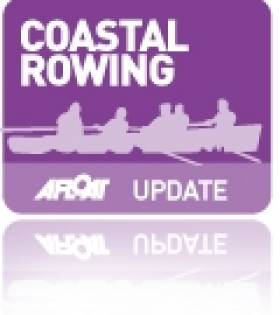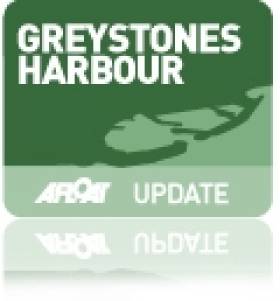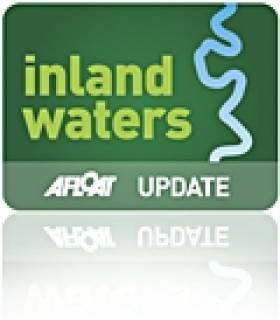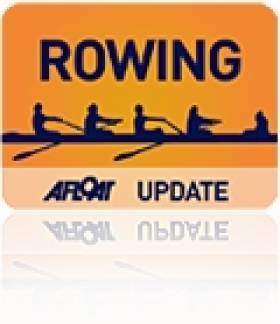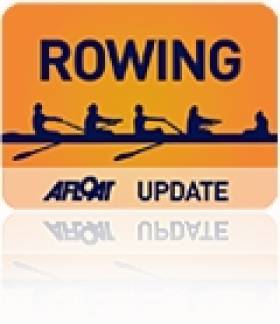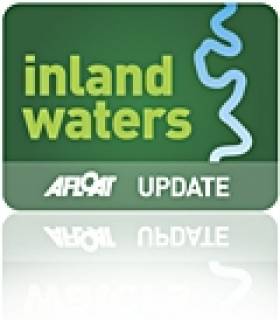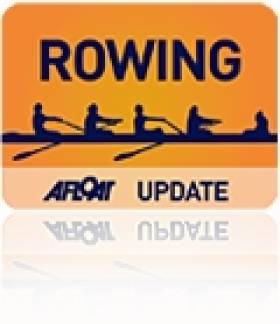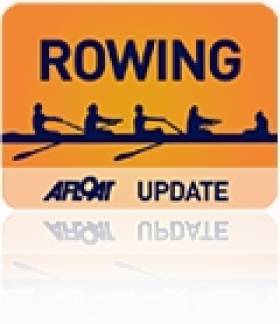Displaying items by tag: rowing
#ROWING – St. Michael's Rowing Club has run into a problem with its Celtic Challenge this weekend after a support boat required to participate in its race across the Irish Sea has been damaged in this week's strong winds, leaving the Dun Laoghaire crew out of the race unless a replacement vessel can be found.
The club is looking for the use of a motor yacht – 33ft or bigger – with or without skipper/crew to help a team of men and women row across the Irish Sea on the Bank Holiday weekend of 4th-6th May.
The support yacht is used to house 2 crews of 4 at a time, with our RIB ferrying crews hourly between the yacht and the rowing boat. All fuel, transport and accommodation will be paid for by the club.
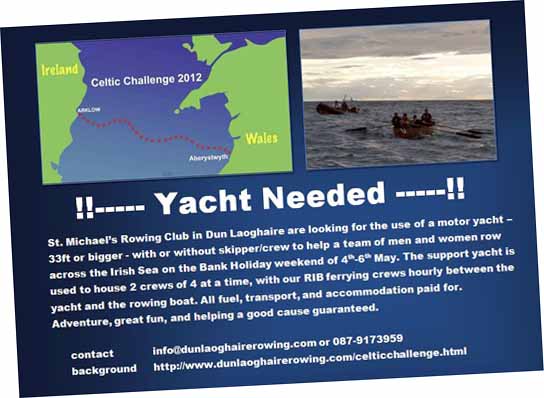
"I know it's short notice but we would cover costs and do not necessarily need a skipper to get us there as we have somebody ready to take that forward' says the club's Gareth Whittington. 'Adventure, great fun, and helping a good cause is guaranteed' he adds.
Contact [email protected] or 087-9173959 if you're interested or know someone who might be.
#COASTAL ROWING – Over the coming May bank holiday weekend (4th-6th May), 12 men and women of St Michael's Rowing Club, Dun Laoghaire, will take part in a biennial rowing race across the Irish Sea known as 'the Celtic Challenge'. The race sets off from Arklow, Co. Wicklow with the finishing line in Aberystwyth, Wales. At 150km, this relay race is billed as the longest 'true' rowing race in the world and draws together 27 teams from Wales, Ireland and beyond. The team is taking on this challenge to raise funds for a clubhouse in Dun Laoghaire, for the first time in the club's 90 year history.
Not many races start and finish in different countries, a source of pride to the Welsh and Irish oarsmen and women involved. So too is the sport of coastal rowing itself, which differs from the Olympic or 'Oxford-v-Cambridge' code of rowing in a number of key ways. Seats are fixed, not sliding, and boats are of a more substantial construction to tackle the swell on the open seas, which can reach several metres.

A St. Michael's boat and crew in training for the Celtic Challenge Cox: Tania Hashmi, Nicola Fitzgerald, Sam Nagle, Kathryn O'Leary, Julia Boyle
St. Michael's take things a step further by using quarter-ton wooden clinker-built east coast skiffs rather than the modern fibreglass models, used by all other competitors in 2010. Their solid wood oars are three times heavier than carbon fibre equivalents, requiring strength and a particular technique. In common with other clubs of Dublin and Wicklow, these boats originate from the 'Hobblers' of old; crews of local men who would engage in unlicensed pilotage of merchant shipping.
Their neighbour in Dun Laoghaire, the now seasonal HSS Stena Explorer consumes 20,000 litres of fuel per hour in crossing the Irish Sea. The St. Michael's squad will be powered by pasta, fig rolls, and energy drinks. But far from taking any moral high ground, the rowers will be glad of the ferry for the return journey home.
Each competing team in the Celtic Challenge consists of three rotating crews of four rowers and is accompanied by a support boat for navigation and for accommodating the resting crews. Changeover strategy is down to each team, but most opt for a one-hour-on, two-hours-off format. Depending on weather conditions, the race may start in Arklow on the afternoon of the Friday, Saturday or Sunday. Crews row through the night, arriving in Aberystwyth the following morning or afternoon.
The squad are actively seeking sponsorship for the challenge, in a drive to raise funds for a new clubhouse in Dun Laoghaire Harbour. Currently, the club lacks space to store their three wooden boats, space for indoor training and is without changing facilities for the men, women and children who row for the club. It is hoped that the money raised can be put towards achieving this long-standing goal.
The event is unique, very challenging and will test the 12 men and women taking part, both mentally and physically. Their oarsmen and oarswomen will have to contend with waves, currents, blisters, seasickness, lack of sleep and the particular challenges of rowing in the dark. The crossing is expected to take over 20 hours, with the St. Michael's Squad currently training hard on land and sea in preparation.
Some of the 2012 squad have made the crossing before, with others new to the event. One such first-timer is Wales born Gareth Whittington, now living in Dun Laoghaire who is relishing the prospect of a free ticket home, "I've been told since I moved here that Welshmen are just Irishmen who couldn't row west to the Promised Land, so I've something to prove to my Irish teammates!"
Rowing Club Gets New Home After 20 Year Wait
#GREYSTONES –After so many flase dawns and its completion marred with controversy Gresytones new harbour in County Wickow welcomed in new residents this week when the developers of the harbour, Sispar, handed over the keys to their new compound to Greystones Rowing Club on Wednesday.
The club has 200 members including 140 juniors, and is a Sea Rowing Club with 3 x 25ft Skiffs and 65 sea kayaks for members.
Founded in the 1920's it has never had premises to keep the boats safely and has been trying to get a place in the harbour since 1992.
'We are delighted with the compound, the launching facilities and the harbour which has been built by Sispar. This will increase the numbers of young people we are able to train' said Alan Monahan, Chairman of the club.
The club is having its annual Regatta on August Bank Holiday Saturday and hope for a lively event with lots of participants and spectators.
Last night Councillor Derek Mitchell welocmed the news 'I am delighted to see the new facilities for the Rowing Club which they have been trying to get for 20 years. When four other clubs move in there will be great action in the harbour for adults and juniors. In Ireland we have ignored the sea even though we are an island nation. This will change that in Greystones at least'
New members of the rowing club are welcome; call 087-6762743
Carrick-on-Shannon Rowing Club "Head of River" Race
#SHANNON NAVIGATION – Carrick-on-Shannon Rowing Club "Head of River" race will take place on Sat 18th Feb 2012 from 09.00 hrs until 17.00hrs. Waterways Ireland has advised Masters of vessels to proceed at slow speed and with minimum wash when passing this stretch of the navigation and to heed any advice or instructions issued by the regatta officials.
Kelly Resting Aboard Cargo Ship After Capsize
#ROWING – Ocean rower Aodhan Kelly is travelling the opposite direction to the one he expected this morning – but he is reported to be safe and well after a tumultous 24 hours. The Dubliner and the five other men in the crew of the Sara G were hoping to set a new record for rowing across the Atlantic from Morocco to Barbados, but they capsized at 11 am yesterday 520 miles from their destination.
The six men stayed in a life-raft t until rescued by the cargo ship the Nord Taipei. The 32,000 tonne craft is continuing on to Gibraltar and is due to arrive on February 9th.
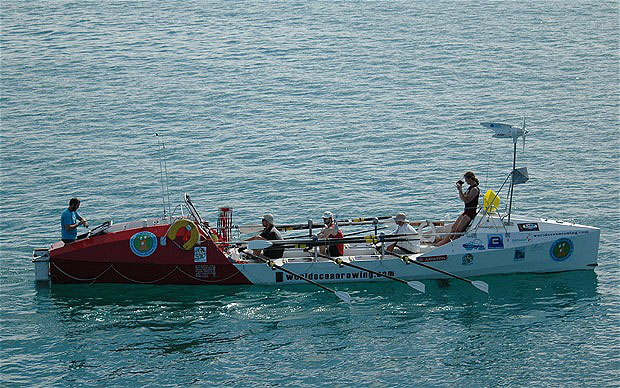
The Sara–G at the start of her now ill-fated journey
The Sara G crew, headed up by the experienced skipper Matt Craughwell, were initally hoping to break what they called the “four-minute mile” of ocean rowing by crossing the Atlantic in under 30 days. But winds and sea conditions were much tougher than expected. They had battled on bravely, with the aim of setting a new record but it all went awry on the 27th day of the row.
The present World Record is held by the 2011 crew of the Sara G - including Craughwell and Irishmen Rob Byrne and Adam Burke – who travelled from Morrocco to Barbados in 33 days 21 hours and 46 minutes in 2011. The Hallin Marine had the shortest crossing, travelling from Tenerife to Barbados in 2011 in 31 days 23 hours and 31 minutes in 2011, but because the distance is shorter the Sara G was deemed the World Record holder by the Ocean Rowing Society.
Kelly, a 26 year old from Palmerstown in Dublin, learned his rowing with Neptune rowing club in Islandbridge for whom he won eight national titles, seven junior and one intermediate. In recent years he has been living and working in Reading in England.
Kelly And Sara G Crew Rescued After Capsize
#ROWING – The crew of the Sara G, including Irishman Aodhan Kelly, have been picked up at sea after a capsize. The shore-based team said the six-man crew were safe and well on board the cargo ship Nord Taipei. The crew had been attempting to break the world record for rowing the Atlantic Ocean.
St Michael's Head Draws A Record 577 Crews
#ROWING–Cold weather isn’t deterring the largest entry to date of Limerick’s St. Michael’s Rowing Club Head of the River(HOR) race which will be held on Saturday, January 28th in O’Brien’s Bridge.
Over 1000 athletes are entered in what is the largest Head of the River race on the Irish rowing calendar. Hosted by St. Michael’s Rowing Club from Limerick, the event has attracted 577 crews from 36 clubs all over the country to race on the River Shannon between Castleconnell and O’Brien’s Bridge.
The superb location is one of the reasons for the popularity of this sporting event. Competitors will commence racing from World’s End, Castleconnell and race against the clock over 3km to finish at O’Brien’s Bridge. The course is held on one of the country’s best stretches of waterway, which provided perfect rowing conditions at the race in 2011.
This is the first major rowing event of the 2012 season. St Michael's HOR was inaugurated in 1981 to fill a gap which existed in the rowing season. Commencing with a modest entry of 63 crews in 1981, the Limerick club has developed the event to be one of the largest rowing events in the country -attracting an annual entry many times of over 500 crews from all four provinces and reaching a new peak of 577 this year.
Chairman of the organising committee Pat McInerney said: “ the growth in the event every year is down to the hard work of the dedicated members of St Michael’s, some of whom have been there since the first race in 1981. The venue is great for both the rowers and the spectators. The past few years has seen a huge growth in junior rowing which in time will drive the senior numbers also.”
Head of River races are essentially time trials, with competitors starting every 15 seconds. This type of racing demands great endurance on the part of each athlete. Spectators will see all types of racing boat at the event from large eight’s powering down the course alongside individuals racing single sculls. Rowers compete in all age groups from Junior 15, 16, 18 to the adult grades of Novice, Intermediate, Senior & Masters levels.
There is a high calibre of entries competing next weekend, with a strong entry from the universities, schools, clubs from all four provinces and some rowers bidding to represent Ireland later this year.
St. Michael’s Rowing Club based at O’Callaghan Strand host the race annually. It takes a massive voluntary effort with over 50 members, parents and friends’ working to ensure everything runs smoothly on the day. St. Michael’s themselves have a big entry of 53 boats with a lot of new junior members getting their first taste of racing. Many of these were recruited over the past year through the successful summer camps which the club ran. Carrying on the back of huge success of the club in the National Championships last year, St. Michael’s are keen to put their stamp on season ahead.
Spectators can come along and enjoy the racing with best vantage points along the banks of the river at O’Briensbridge or you can see the starts at Worlds End in Castleconnell.
Waterways Ireland Issues a 'Special Notice' to Mariners for 2012
#WATERWAYSIRELAND – In its first notice to mariners of 2012 Waterways Ireland has published a list of the most important aspects of waterways regulations for boat owners. It includes the Registration of Vessels, Canal Permits, Events Held on the Waterways, Berthing in Public Harbours and many more useful reminders for the use of the waterways this coming season. Full details of the 'special notice' from the Inspector of Navigation Charles J Lawn Lt Cdr (rtd) is below:
Registration of Vessels
All vessels using the Shannon Navigation and the Erne System must be registered. Only open undecked boats with an engine of 15 horsepower or less, on the Shannon Navigation, and vessels of 10 horsepower or less, on the Erne System, are exempt.
Canal Permits
All vessels using the Grand and Royal Canals and the Barrow Navigation must have a current valid Permit displayed before being navigated or moored.
Events Held on the Waterways
All organised events taking place on the waterways must have the prior approval of Waterways Ireland. Application forms for this approval and the associated indemnity form may be had from the Inspectorate offices.
Berthing in Public Harbours
On the Shannon Navigation and the Shannon-Erne Waterway craft may berth in public harbours for five consecutive days or a total of seven days in any one month during the period 1 April to 31 October. This also applies in Clondara / Richmond Harbour on the Royal Canal and in Shannon Harbour and the Tullamore Spur Line on the Grand Canal.
On the Erne System no vessel may berth at a public mooring for more than 48 hours without a four hour intermission.
Pump Out Berths
Masters of vessels should note that it is not permitted to berth at pump out stations.
Smart Cards
Waterways Ireland smart cards are used to operate certain locks, to access the service blocks and to use the pump-outs along the navigations. Electrical Power is also available using smart cards at a limited number of public mooring locations, including Scarriff, Shannonbridge, Garrykennedy, Carrick and Ballina (Tipperary). Operating instructions are displayed in English, French and German.
Passenger Vessel Berths
Masters of vessels should not berth on passenger vessel berths where it is indicted that an arrival is imminent. Passenger vessels plying the navigations generally only occupy the berths to embark and disembark passengers and rarely remain on the berths for extended periods or overnight.
Lock Lead-in Jetties
Lead-in jetties adjacent to the upstream and downstream gates at lock chambers are solely for the purpose of craft waiting to use the lock and should not be used for long term berthing.
Vessel Wash
Vessel wash, that is, the wave generated by the passage of the boat through the water, can sometimes be large, powerful and destructive depending on the hull shape and engine power of the vessel. This wash can be detrimental to other users of the navigation when it strikes their craft or inundates the shoreline or riverbank. Masters are requested to frequently look behind and check the effect of their wash particularly when passing moored vessels, on entering harbours and approaching jetties and to be aware of people fishing or recreating on the riverbank.
Speed Restriction
A vessel or boat shall not be navigated on the Shannon Navigation at a speed in excess of 5 kph when within 200 metres of a bridge, quay, jetty or wharf, when in a harbour or canal or when passing within 100 metres of a moored vessel or boat.
Vessels navigating the Shannon-Erne Waterway should observe the general 5 kph speed limit which applies along the waterway. This is necessary in order to prevent damage to the banks caused by excessive wash from vessels.
Vessels navigating the Erne System should observe the statutory 5 kt / 6mph/10kph speed limit areas.
Bank Erosion
Narrow sections of all the navigations are particularly prone to bank erosion due to the large wash generated by some craft. Masters are requested to be vigilant and to slow down to a speed sufficient to maintain steerage when they observe the wash of their craft inundating the river banks.
Unusual Waterborne Activity
Unusual waterborne vessels may be encountered from time to time, such as, hovercraft or amphibious aircraft / seaplanes. Masters of such craft are reminded to apply the normal "Rule of the Road" when they meet conventional craft on the water and to allow extra room to manoeuvre in the interest of safety.
Sailing Activity
Mariners will encounter large numbers of sailing dinghies from late June to August in the vicinity of Lough Derg, Lough Ree and Lower Lough Erne. Vessels should proceed at slow speed and with due caution and observe the rules of navigation when passing these fleets, as many of the participants are junior sailors under training.
Rowing
Mariners should expect to meet canoes and vessels under oars on any part of the navigations, either recreating, in training or in competition but more so in the vicinity of Athlone, Carrick-on-Shannon, Coleraine, Enniskillen and Limerick. Masters are reminded to proceed at slow speed and especially to reduce their wash to a minimum when passing these craft as they can be easily upset and swamped due to their very low freeboard and always be prepared to give way in any given traffic situation.
Canoeing
Canoeing is an adventure sport and participants are strongly recommended to seek the advice of the sport's governing bodies i.e The Irish Canoe Union and the Canoe Association of Northern Ireland, before venturing onto the navigations.
Persons in charge of canoes are reminded of the inherent danger to these craft associated with operating close to weirs, sluice gates, locks and other infrastructure particularly when rivers are in flood and large volumes of water are moving through the navigations due to general flood conditions or very heavy localised precipitation e.g. turbulent and broken water, stopper waves. Shooting weirs is prohibited without prior permission of Waterways Ireland.
Portage is required at all locks, however, a heavily laden canoe may be put through a lock unmanned provided it is attended with a head and stern line.
Fast Powerboats and Personal Watercraft (Jet Skis)
Masters of Fast Powerboats (speed greater than 17kts) and Personal Watercraft (e.g.Jet Skis) are reminded of the inherent dangers associated with high speed on the water and especially in the confines of small bays and narrow sections of the navigations. Keeping a proper look-out, making early alterations to course and /or reducing speed will avoid conflict with slower vessels using the navigation.
Age Restrictions
In the Republic of Ireland you have to be at least 16 years of age to operate a PWC e.g Jetski and 12 years of age or over to operate a vessel with more than a 5 hp engine.
Prohibition on Swimming
Swimming in the navigable channel, particularly at bridges, is dangerous and is prohibited due to the risk of being run over by a vessel underway in the navigation.
Towing Waterskiers, Wakeboarders, Doughnuts etc
Masters of vessels engaged in any of these activities are reminded of the manoeuvring constraints imposed upon their vessel by the tow and of the added responsibilities that they have to the person(s) being towed. These activities should be conducted in areas which are clear of conflicting traffic. It is highly recommended that an person additional to the master be carried to act as a "look-out" to keep the tow under observation at all times.
Lifejackets and Personal Flotation Devices (PFD's)
Lifejackets and PFD's are the single most important items of personal protective equipment to be used on a vessel and should be worn especially when the vessel is being manoeuvred such as entering / departing a lock, anchoring, coming alongside or departing a jetty or quayside.
In the Republic of Ireland all persons on board any craft of less than 7m (23 ft) must wear a lifejacket or PFD while on board an open craft or on the deck of a decked craft that is not made fast to the shore. This requirement also applies to Personal Watercraft Craft and any vessel or object being towed e.g. waterskier, wakeboarder, doughnut, banana etc.
Danger Area
The attention of mariners is drawn to the Army Firing Range situated in the vicinity of buoys No's 2 and 3, on Lough Ree in the Shannon Navigation.
Shannon Navigation, Portumna Swing Bridge Tolls
No attempt should be made by Masters' of vessels to pay the bridge toll while making way through the bridge opening. Payment will only be taken by the Collector from Masters when they are secured alongside the jetties north and south of the bridge.
Shannon Navigation, Abbey River and Sarsfield Lock, Limerick
The attention of all users of this stretch of the Shannon Navigation is drawn to the published notices regarding navigation. Users are advised to contact the ESB Ardnacrusha Hydroelectric Power station before commencing their passage to ascertain how many turbines are currently running. It is advised NOT to undertake a voyage if more than one turbine is operating, due to the increased velocity of flow in the navigation, which can be dangerous. This situation may also arise when flood conditions prevail. Further, passage of Sarsfield Lock should be booked on 353-87-7972998, on the day prior to travel and it should be noted also that transit is not possible two hours either side of low water.
Lower Bann Navigation
The attention of all users is drawn to the "Users Code for the Lower Bann", in particular to that section covering "Flow in the River" outlining the dangers for users both on the banks and in the navigation associated with high flow rates when the river is in spate. Canoeists should consult and carry a copy of the "Lower Bann Canoe Trail" guide issued by the Canoe Association of Northern Ireland.
Overhead Power Lines (OHLP)
The attention of all is drawn to the dangers associated with overhead power lines in particular sailing vessels, sailing dinghys and workboats with cranes. Vigilance is required especially in the vicinity of slipways and dinghy parks, while voyage planning is a necessity in order to identify the location of overhead lines crossing the navigations. If the vessel or its equipment comes in contact with an OHLP, do NOT attempt to move the equipment or a person if either is still in contact with, or close to, the OHLP. The conductor may still be alive or re-energise automatically. Maintain a 5 m clearance, if possible, and prevent third parties from approaching you or your vessel because of the risk of arcing. Contact the Coast Guard for assistance. Fishermen are also reminded that a minimum ground distance of 30 metres should be maintained from overhead power lines when using rod and line.
Submarine Cables and Pipes
Masters of vessels are reminded not to anchor their vessels in the vicinity of submarine cables or pipes in case they foul their anchor or damage the cables or pipes
Aids to Navigation – Shannon Navigation - Recognition
Masters should consult Waterways Ireland Marine Notices to inform themselves of the roll-out of the change over from the colour black to green for starboard hand marks. Topmarks remain the same i.e square on starboard and circular on port marks. White arrows on markers indicate the safe water side of the mark.
Caution to be Used in Reliance upon Aids to Navigation
The aids to navigation depicted on the navigation guides comprise a system of fixed and floating aids to navigation with varying degrees of reliability. Therefore, prudent mariners will not rely solely on any single aid to navigation, particularly a floating aid to navigation. With respect to buoys, the buoy symbol is used to indicate the approximate position of the buoy body and the ground tackle which secures it to the lake or river bed. The approximate position is used because of the practical limitations in positioning and maintaining buoys in precise geographical locations. These limitations include, but are not limited to, prevailing atmospheric and lake/river conditions, the slope of and the material making up the lake/river bed, the fact that the buoys are moored to varying lengths of chain, and the fact that the buoy body and/or ground tackle positions are not under continuous surveillance. Due to the forces of nature, the position of the buoy body can be expected to shift inside and outside the charted symbol. Buoys and perches are also moved out of position by those mariners who use them to moor up to instead of anchoring. Further, a vessel attempting to pass close by always risks collision with a yawing buoy or with the obstruction that the buoy or beacon / perch marks.
- rowing
- canoeing
- Registration of Vessels
- Canal Permits
- Events Held on the Waterways
- Berthing in Public Harbours
- Pump Out Berths
- Smart Cards
- Passenger Vessel Berths
- Lock Leadin Jetties
- Vessel Wash
- Speed Restriction
- Bank Erosion
- Unusual Waterborne Activity
- Sailing Activity
- Fast Powerboats and Personal Watercraft (Jet Skis)
- Age Restrictions
- Towing Waterskiers, Wakeboarders, Doughnuts
Kelly and Crew Take to the Sea in World Record Attempt
#ROWING - Irishman Aodhan Kelly and five crewmates set off from Tarfaya in Morocco today in an attempt to set a new record for rowing the Atlantic Ocean. The Sara G, under skipper Matt Craughwell, left port at 1pm on a journey to Barbados which they hope will take 30 days or under.
Below is a vide clip of Sara G from a year ago. The expedition is completely different but gives an idea of what Aodhan and his crew mates face on the voyage across the Atlantic.
Comprehensive 2012 Calendar For Irish Rowers
#ROWING – The year ahead will be a bumper one for rowing. Check out the 2012 Calendar - with a month-by-month list of domestic and international fixtures.
Rowing Calendar 2012
January 21st: Sligo Head of the River. 28th: St Michael’s Head, O’Brien’s Bridge.
February 4th: Lagan Scullers Head, Belfast. 18th: Head of the Shannon, Carrick-on-Shannon; Cork Head, Marina. 25th: Lagan Head, Belfast.
March 3rd: Erne Head, Enniskillen; Fermoy Head; Women’s Eights Head, London. 17th: Tribesmen Head, Galway; Head of the River, London. 19th: Gannon Cup Colours Races, Dublin (morning); 24th: Dublin Head.
April 1st: Monkstown Sprint Regatta, National Rowing Centre, Cork. 7th: Trinity Regatta, Islandbridge, Dublin. 14th: Irish University Championships and Irish Schools’ Regatta, NRC. 15th: Skibbereen Regatta, NRC. 21st: Neptune Regatta, Islandbridge. 28th: Queen’s Regatta, Castlewellan; Bantry Regatta, Bantry.
May 4th-6th: World Cup One, Belgrade. 5th: Portadown Regatta. 5th-6th: Munich Junior Regatta. 5th-6th: Ghent International May Regatta. 12th: Limerick Regatta, O’Brien’s Bridge. 19th: Belfast Sprint Regatta; Lee Regatta, Cork Harbour. 20th-23rd: Final Olympic Qualification Regatta, Lucerne. 25th-27th: World Cup Two, Lucerne. 26th: Metropolitan Regatta, Blessington.
June 2nd-3rd: Carlow Regatta; (British) Metropolitan Regatta, Dorney Lake; International Junior Regatta, Hamburg. 10th: Castleconnell Sprint Regatta, O’Brien’s Bridge; 15th-17th: World Cup Three, Munich; 15th-17th: Henley Women’s Regatta; 16th: Athlone Regatta, Coosan Point; 17th: Galway Regatta; 16th-17th: Marlow Regatta, Dorney Lake. 23rd: Cork Regatta, NRC; 23rd-24th: National Assessment (Junior Trials), NRC; 24th: Fermoy Sprints; 27th-July 1st: Henley Royal Regatta.
July 1st (from June 27th): Henley Royal Regatta; 11th-15th: World Under-23 Championships, Trakai, Lithuania; 12th-15th: National Championships, National Rowing Centre, Farran Wood, Cork; 20th-22nd: Coupe de la Jeunesse, Banyoles, Spain. 21st (Provisional) Home International Regatta, Cardiff; 28th-August 4th: Olympic Games Regatta, Dorney Lake, England.
August (from July 28th) to 4th: Olympic Games Regatta, Dorney Lake, England. 5th: Carrick-on-Shannon Sprints; 15th-19th: World Senior and Junior Championships, Plovdiv, Bulgaria; 24th-26th: All-Ireland Coastal Rowing Championships, Broadstrand, Courtmacsherry, Co Cork; 25th Belfast Summer Sprints; 31st-September 2nd: Paralympic Regatta, Dorney Lake, England.
September (from August 31st) to 2nd: Paralympic Regatta, Dorney Lake, England; 6th-9th: World Masters Regatta, Duisburg, Germany; 7th-9th: World University Championships, Kazan, Russia. 14th-16th: European Championships, Varese, Italy.
October 7th: Tullamore Time Trial; 20th: Skibbereen Head of the River, NRC; 20th-21st: Head of the Charles, Boston, Massachussets.
November 1st-4th: World Rowing Coaches Conference, Limerick. 3rd: Castleconnell Head of the River, O’Brien’s Bridge; 10th: Neptune Head of the River, Blessington; Fours Head of the River, London. 17th: Bann Head of the River, Coleraine. 24th-25th: National Assessment, Newry.





























